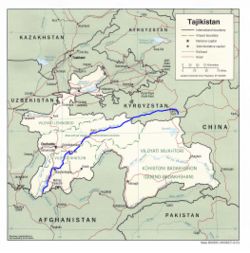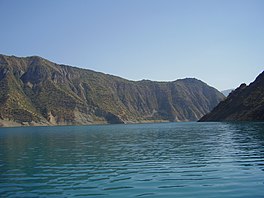Vakhsh (river)
| Vakhsh | |
|---|---|
 The river Vakhsh (highlighted in blue) | |
| Location | |
| Country | Kyrgyzstan, Tajikistan |
| Physical characteristics | |
| Mouth | Amu Darya |
• coordinates | 37°06′40″N 68°18′51″E / 37.1112°N 68.3141°E |
| Length | 786 km (488 mi) |
| Basin size | 39,100 km2 (15,100 sq mi) |
| Discharge | |
| • average | 621 m3/s (21,900 cu ft/s)[1] |
| Basin features | |
| Progression | Amu Darya→ Aral Sea |
The Vakhsh (
Geography
The Vakhsh flows through the
After it exits the Pamirs, the Vakhsh passes through the fertile lowlands of southwest Tajikistan.
The catchment area of the Vakhsh is 39,100 km2, of which 31,200 km2 (79.8%) lies within Tajikistan. The river contributes about 25% of the total flow of the Amu Darya, its
Economic development
| Nurek Reservoir | |
|---|---|
 The Vakhsh River forms a reservoir behind the Nurek dam | |
| Coordinates | 38°19′40″N 69°23′00″E / 38.32778°N 69.38333°E |
The Vakhsh has been intensively developed for human use. Electricity, aluminum, and cotton are the mainstays of Tajikistan's economy,
Soviet era
The leaders of the Soviet Union stressed the importance of developing the country's under-developed regions, such as the Tajik Soviet Socialist Republic (which was the predecessor to modern-day, independent Tajikistan). Not only did Vladimir Lenin’s ideology identify the decentralization of industry as a way to counter the colonial exploitation of indigenous peoples, but the USSR had strategic aims as well, especially in World War II when industry was evacuated eastward away from the German front.[8] This industrialization would be fueled by exploiting Tajikistan's enormous hydropower potential.
It took until the 1950s, however, for dam construction to begin on the Vakhsh. The Perepadnaya power station, was the first to be commissioned in 1959. It is situated on a canal off the Golovnaya Dam which was commissioned in 1963. The giant Nurek dam was constructed between 1961 and 1980. Baipaza Dam was completed in 1983.
To build transmission lines over the Pamirs would have been prohibitively expensive, so, in order to take advantage of the electricity produced by these dams, the Soviet Union built many industries nearby.[9] The Tajik Aluminum Company plant is a prime example. Other industries established locally were chemical plants, nitrogen fertilizer factories, and cotton gins.[10]
The dams, particularly the reservoirs behind them, were also built with the purpose of providing water for agriculture. The Soviet Union promoted cotton farming in the Vakhsh Valley, as well as vineyards and orchards, and drew water from the Vakhsh for irrigation. The Vakhsh Valley Canal Project, which expanded farmland along the river's lower reaches, predated the dams, having been completed in 1933. In the 1960s, after the reservoirs had been constructed, engineers dug tunnels through the surrounding mountains to irrigate other valleys.[11] Water storage in the reservoirs also helped control the river's flow, so as to provide a more reliable water supply for downstream users in Uzbekistan and Turkmenistan.[3]
After Tajik independence
Soviet Central Asia had a centrally planned economy in which the different republics supplied resources to each other at different times of the year. During the summer, when river flows were greatest, Tajikistan (located upstream) released water from its reservoirs on the Vakhsh and exported the hydroelectricity to power irrigation pumps downstream, in Uzbekistan and Turkmenistan, along the Amu Darya. In winter, Tajik dams accumulated water, and the fossil-fuel-rich downstream nations supplied Tajikistan with oil and gas to compensate for forgone hydroelectricity generation.
However, with increasing regional tension post-independence, this system is breaking down, with no conclusive cooperative arrangement yet. Fuel deliveries from downstream nations have been getting less reliable and more expensive, and impoverished Tajikistan cannot adapt by increasing winter hydroelectric generation since this would jeopardize irrigation and electricity exports in the summer. This dependence has caused energy crises in the winters of 2008 and 2009, in which the capital, Dushanbe, lost power and heating. Heightened nationalism and border disputes further complicate the search for a solution to Central Asia's water needs, according to a study conducted by the International Crisis Group.[12]
Tajikistan is therefore pursuing a course of action to increase hydroelectric capacity by building more dams on the Vakhsh, in order to promote economic growth and move towards energy independence.
This project has caused great controversy. Just as energy dependence threatens Tajikistan, so water dependence threatens the downstream nations. For this reason, Uzbekistan was highly critical of the Rogun Dam, claiming that it would “put it [Tajikistan] firmly in control of the river”.[3] The World Bank responded to these tensions by launching investigations into the social and environmental impacts of the dam.[13] However, following the death of its former leader Islam Karimov in 2016, in 2018 Uzbekistan dropped its opposition to the Rogun Dam. "Go ahead and build it, but we hold to certain guarantees in accordance with these conventions that have been signed by you," Uzbek Foreign Minister Abdulaziz Komilov said in a televised appearance on July 5, 2018.[14]
Environmental problems
Intensive agriculture in the Vakhsh basin has left the river polluted with fertilizers, pesticides, and salts. Also, chemicals have leached into groundwater from the heavy industries near the Vakhsh's dams, which has in turn contaminated surface water.
Since the waters of the Vakhsh eventually flow into the Aral Sea, pollution in the Vakhsh contributes to eutrophication there.[7]
Climate change impacts
The Vakhsh is fed by the glaciers of the Pamirs, one of the world's most susceptible regions to climate change. Tajikistan as a whole has experienced a rise in temperatures from between 1.0-1.2 degrees Celsius between 1940 and 2000, and many glaciers that feed the Vakhsh have retreated, including the
Blockages
The Vakhsh is located in a seismically active region, and earthquakes, in addition to high groundwater levels (especially during the wet season), cause hundreds of landslides per year.[17] These landslides occasionally block the river and form landslide dams.
Such blockages pose a significant threat to the river's dams and hydroelectric power generation. A large landslide 8 kilometers (5 mi) downstream from the
Recognizing these threats, the Asian Development Bank responded to the landslide of 2002 by granting the government of Tajikistan a low-interest loan to stabilize the valley slopes and mitigate the potential for blockages in the future.[18]
Notes
- ^ "Vakhsh at Golovnaya Hyd'Elec'Power". Soviet Union Hydro-Station archive. UNESCO. 1936–1985. Retrieved 2014-02-01.
- ^ a b c "Tajikistan - Topography and Drainage" in Tajikistan: a Country Study (Washington: Library of Congress, 1996)
- ^ a b c d e Kai Wegerich, Oliver Olsson, and Jochen Forebrich, “Reliving the past in a changed environment: Hydropower ambitions, opportunities and constraints in Tajikistan”, Energy Policy 35 (2007), 3815-3825
- ^ Mary Pat Silviera et al., Environmental Performance Reviews: Tajikistan. (New York and Geneva: United Nations, 2004), 124
- ^ a b Silviera et al., Environmental Performance Reviews, 4
- ^ “VIII. Regional and Country Hydropower Profiles: CIS,” in Hydropower Report: Large & Small Hydropower Archived 2011-09-03 at the Wayback Machine (London: ABS Energy Research, 2005), 59-62.
- ^ a b c d e Silviera et al., Environmental Performance Reviews, 104-109
- ^ Violet Conolly, Beyond the Urals: Economic Developments in Soviet Asia (London: Oxford University Press, 1967), pp. 61-62
- ^ Conolly, Beyond the Urals, pp. 145-149
- ^ Conolly, Beyond the Urals, p. 172
- ^ Conolly, Beyond the Urals, pp. 208-220
- ^ International Crisis Group. "Water Pressures in Central Asia", CrisisGroup.org. 11 September 2014. Retrieved 6 October 2014.
- ^ a b Murodbek Laldjebaev, “The Water-Energy Puzzle in Central Asia: The Tajikistan Perspective,” Water Resources Development 26 (2010): 23-34.
- ^ Uzbekistan and Tajikistan: No more dam problems?
- ^ Silviera et al., Environmental Performance Reviews, 165
- Oxfam International, 2009), 1-22
- ^ Silviera et al., Environmental Performance Reviews, 17
- ^ Report and Recommendation of the President to the Board of Directors on a Proposed Loan to the Republic of Tajikistan for the Baipaza Landslide Stabilization Project (Manila: Asian Development Bank, 2003).

